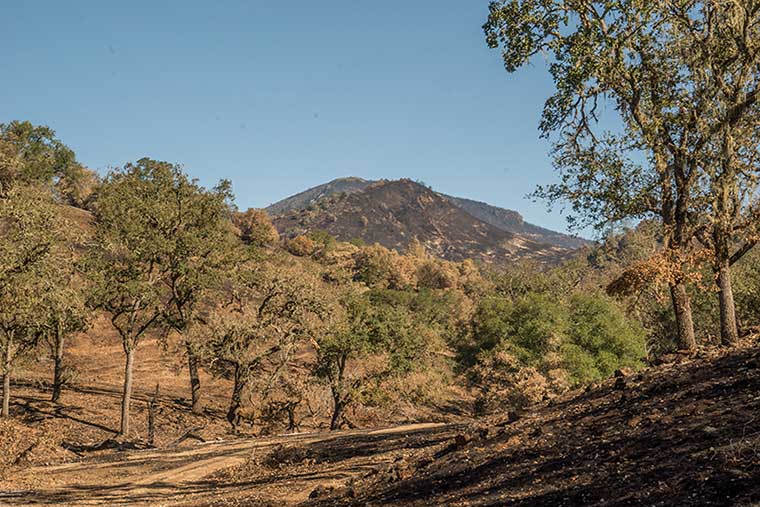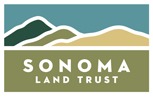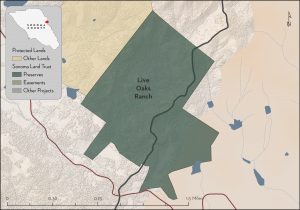LIVE OAKS RANCH
Bridge to Safety
When the Tubbs Fire ignited in October 2017, it swept through the Mayacamas Range and quickly spread through Live Oaks Ranch. As grasses and oak trees ignited, the fire surrounded the homestead, consuming outbuildings and licking at the walls of the ranch’s two homes. Our tenants fled earlier, thankfully, but the fate of the houses was less secure.
Fortunately, just days before, the Land Trust had finished work on a new free span bridge over Bidwell Creek to the homestead. The new bridge was constructed to allow steelhead to migrate underneath and to meet current building codes, including fire codes. The completion of that project at that time proved highly fortuitous.
If it were not for our newly complete, fire-safe bridge, the fire would likely have claimed the ranch house, the cottage and all the farm buildings. Instead, firefighters in their heavy firetrucks were able to safely access the ranch and save the buildings mere minutes before the flames probably reached them.
As stewardship staff noted, the dilapidated old bridge was unlikely to have supported the weight or length of the firetrucks that arrived at the property that night, underscoring the importance of keeping our ranch infrastructure well-maintained and functioning properly.
The fire did burn all 572 acres of Live Oaks Ranch, affecting both the natural environment and the farmstead. The intensity of the fire was fairly low across the grasslands and through the woodlands, though we sadly lost a number of large coast live oaks in the Bidwell Creek valley. Fortunately, however, the winter rains that followed did not cause any significant erosion and the ground has remained stable.
Many people ask about how the wildlife survived the fires. Live Oaks Ranch is part of a large, relatively undeveloped block of ranches and oak woodlands. The complexity of habitat, varying topography and creek corridors likely provided refuge for wild animals to flee, climb or hide from the flames. Since the fire, stewardship staffers have continued to encounter healthy wild animals on the property.
Property Bequest
This important wildlife passage in the Mayacamas would probably not exist had it not been for Marie “Rie” Rogers, the woman who generously left Live Oaks Ranch to the Land Trust in her will. When Marie Rogers passed away, she bequeathed her stunning ranch above Knights Valley to Sonoma Land Trust. The ranch, which straddles the Sonoma/Napa County line, is also protected by a conservation easement held by the Land Trust of Napa County, providing further assurance that this largely untouched landscape will not be developed further.
Rie Rogers also very generously left Sonoma Land Trust with a stewardship fund to help manage the property. This fund allows us to help realize the vision she had for her ranch and to enhance the habitat that she wanted protected for all time.
Live Oaks Ranch represents the largest bequest Sonoma Land Trust has ever received. Rie’s friendship with Charlie Laufenburg, who left his 176-acre Laufenburg Ranch to the Land Trust in 1987, inspired her to bequest her property as well. Her passion for protecting the natural, undeveloped state of her ranch was legendary.
Live Oaks Ranch is a place of amazing natural beauty. The headwaters of Bidwell Creek (which also flows through Laufenburg Ranch downstream) form in the valley, which features lovely wildflower displays in the spring. Bidwell Creek is an important waterway, home to steelhead trout, freshwater shrimp and, hopefully, coho salmon, all of which are protected under the Endangered Species Act. Though fish haven’t been documented on the property in years, we’re stewarding the land and our waterways so we’ll be ready when the fish return. This means we’re removing obstacles in the stream (like old bridges) and future plans call for restoring more natural flows to the floodplain. The ranch is also home to a number of springs and small waterfalls, mixed oak and coniferous woodlands, and the wild animals who depend on them. We also work with a local cattle rancher to manage the grasslands for food and habitat.
Three-phase Restoration of Bidwell Creek

Nestled at the base of Mount St. Helena, the hills of Live Oaks Ranch create the headwaters of Bidwell Creek. Approximately 1.3 miles of the creek run through these rugged, oak-covered hills. Threatened and endangered species, such as steelhead, freshwater shrimp, California red-legged frogs and (possibly) Coho salmon, call this creek home. Much of Bidwell Creek on the property is in good condition and provides adequate habitat for a variety of wildlife. However, some downstream portions on the property have experienced habitat degradation and this is our opportunity to help.
Sonoma Land Trust is working on a three-phase plan to improve habitat and water quality in Bidwell Creek. Phase 1 was completed as a partnership project with the Sonoma Resource Conservation District (RCD). Over 200 new plants have been installed along this riparian corridor, helping to reduce erosion, provide shade along the stream, create food sources for wildlife, and provide cover and new habitat for wildlife.
Over the summer, the Land Trust implemented Phase 2 of the restoration plan in which we removed a failing, potential fish barrier and replaced it with a free span bridge. The bridge allows safe passage for aquatic wildlife, reduces erosion that degrades water quality and helps to restore the natural flow of the stream through this reach of the creek.
This part of Bidwell Creek is deeper than it once was and has steep banks; currently, during rain storms, the creek and surrounding floodplain rarely flood. Flooding is a natural process needed by riparian habitats — it allows nutrients to reach the meadow and vice versa, and it recharges the groundwater that provides flow into the creek during the dry months. The Land Trust and the Sonoma RCD are joining forces again to design and implement a Wet Meadow Restoration project, which will encourage flooding into ancient channels that were once occupied during large storms throughout the floodplain meadow. This extra water could be crucial to aquatic wildlife in the creek.
The Fire and the Recovery

In October 2017, the Tubbs Fire burned the entire 572 acres of Live Oaks Ranch. We sustained losses to miles of cattle fencing and two garages, and had other infrastructure-related damages as well. Most of the fire on the ranch was of relatively low intensity, burning the understory of the forest without major losses to the larger, established trees. The diversity of vegetation on the property offers us a lesson about how native plants are adapted to fire. The charred chaparral plants are sprouting anew from their base, while the large old oak trees and mature Douglas fir trees withstood the fire with their thick bark, replacing the baked leaves with green ones by spring. The grasses were the first to recover, sprouting back just weeks after the fire.
Native species don’t just withstand fire, but many flourish after it. The oak trees benefit from the fire clearing out competition and many conifer species need fire for their cones to release seeds. Fire also reduces built-up thatch in grasslands, giving native grasses a chance to compete more effectively for space and sunlight. Fire is a natural process and all native species are equipped to survive it. We will continue to observe and learn from this natural recovery process for years to come.
In order for the ranch to continue to recover from the fire, we need to change our land management practices. This may sound counter-intuitive, that we have to help nature, but this landscape, like much of Sonoma County, has been heavily shaped by human activity. We have largely removed fire from the landscape and this has allowed the woodlands and natural areas to grow unnaturally thick. Combined with the drier, longer summers, this creates conditions that threaten the natural and human communities.
Our goal is to return fire to its more natural role on the landscape. To do this, we need to manage the vegetation to help return it to a sustainable state. In 2020, the Land Trust completed a forest management plan that identified areas that would benefit from thinning the many small trees and sprouts that are growing in too thickly after the fire. There are areas where we want to support the oak woodland habitats and need to thin some Douglas fir. And there are existing fire breaks we want to maintain so that firefighters have a safe place to work from in case of another catastrophic wildfire. In the next few years, we hope to work with neighbors and begin the use of prescribed fire to manage the landscape to mimic the native fire regime.









